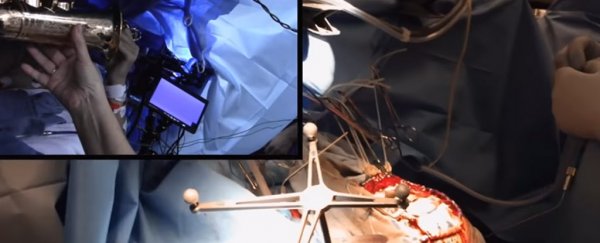It's not unusual for patients to remain awake during brain surgery. This helps surgeons monitor the effect the surgery is having on the patient's brain in real time. It's pretty unusual for the patient to play an instrument, though.
In the case of Dan Fabbio, playing a saxophone during his surgery had an even broader impact. It helped a team of researchers study and better understand how the brain processes music. And now we all get to watch the resulting footage!
A music teacher, Fabbio was just 25 when he was diagnosed with a brain tumour in 2015. It was benign, but there was still a big problem. The mass was sitting directly on a region that's important for music function.
The solution? Keep Fabbio awake and playing his saxophone while the surgeons removed the tumour.
The team was led by the University of Rochester Medical Center's Web Pilcher, a professor of neuromedicine and chair of the department of neurosurgery. Together with Brad Mahon, he had developed a brain mapping program for brain surgery patients.
"Removing a tumour from the brain can have significant consequences depending upon its location," Pilcher said in a press release. "Both the tumour itself and the operation to remove it can damage tissue and disrupt communication between different parts of the brain."
"It is, therefore, critical to understand as much as you can about each individual patient before you bring them into the operating room so we can perform the procedure without causing damage to parts of the brain that are important to that person's life and function."
Each patient's brain needs to be mapped individually, since everyone's brain is slightly different. Usually, these just entail language and motor tests, but to help map the brain of a trained professional musician, Pilcher and Mahon recruited music cognition expert Elizabeth Marvin from Rochester's Eastman School of Music.
Together, the three devised a series of tests that allowed them to build a three-dimensional map of Fabbio's brain.
The next challenge was figuring out how Fabbio could play his saxophone. He would need to be laying on his side for the procedure, which compresses the lungs and does not allow for full normal capacity. In addition, inhaling deeply for long notes had the potential to cause the brain to protrude from Fabbio's open skull during the surgery.
With Marvin's help, Fabbio devised a version of a Korean folk song that only required shallow breaths.
"The whole episode struck me as quite staggering that a music theorist could stand in an operating room and somehow be a consultant to brain surgeons," Marvin said.
"In fact, it turned out to be one of the most amazing days of my life because if felt like all of my training was suddenly changing someone's life and allowing this young man to retain his musical abilities."
Fabbio isn't the only musician whose abilities assisted surgeons during an important surgery. Professional violinist Roger Frisch played his instrument throughout a procedure to determine the source of tremors in his brain that was affecting his playing.
In 2015, Anthony Kulkamp Dias played a Beatles tune on his guitar during his surgery. It never gets any less astonishing.
While the surgeons removed his tumour, Fabbio performed the humming and language tasks that the team had developed for him. Then, when the tumour was removed, his skull still open, Fabbio was handed his saxophone to make sure everything had gone to plan.
"It made you want to cry," Marvin said. "He played it flawlessly and when he finished the entire operating room erupted in applause."
The team's research was published in the journal Current Biology.
